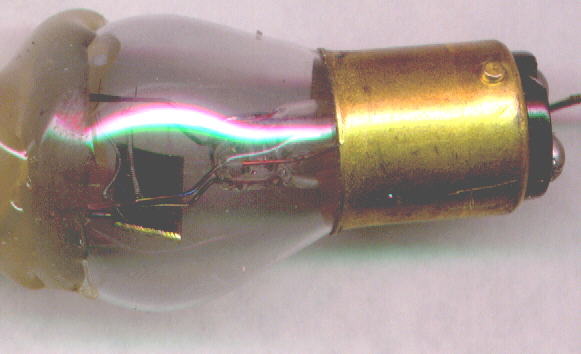

This is a follow up experiment from the report that I wrote previously about home evacuation of a vacuum tube. The next step is to make my own vacuum tube from scratch. This is my first attempt, a diode. The diode seems to work surprisingly well and makes the thought of putting a grid between the filament and the plate very encouraging.
The diode was tested on an old tektronix 575 curve tracer. It was necessary to apply almost the full 12 volts to the filament in order to get any action. Commercial vacuum tubes use some kind of thorium treated filaments which allow them to emit electrons at a much lower temperature. This filament, being just plain tungsten, had to be near its normal incandescent temperature in order to emit electrons. With the filament connected to a 12 volt battery, It was very easy to get well over 100 milliamps of plate current - very surprising! I have always wondered if it would be necessary to have a thoriated filament in order to make a vacuum tube. It definitely seems not. Tungsten seems to work very well; you just have to run it at a higher temperature.
The plate, with no voltage applied and connected to a dc voltmeter, produced negative two and one half volts. The curve of the plate conduction shows a slight amount of current increase up to several volts applied between the filament and the plate. After several volts, the current starts to increase at a very steep rate with rise in plate voltage. I also noticed what appears to be a small negative resistance region in the curve at about 125 milliamps and 30 volts. This resembles the negative resistance region of a tunnel diode. I noticed similar things during the previous experiments with the vacuum tube. I can't be sure yet if the curve tracer is playing tricks of if there is something really interesting going on here.
The vacuum tube diode was made from an automobile tail lamp. As can be seen in the picture, the top was filed open with an abrasive stone made for filing glass. The hole in the top was made large enough to slip in a small brass plate and the evacuation tube.
The plate was a small piece of brass (.025 thick) soldered to a wire. The hose and the plate wire were hot glued to the top in order to make the seal and hold the plate near one of the filaments. The plate was spaced several millimeters from the heavy filament.
The tube was evacuated with the same Robinair vacuum pump as mentioned before. Most of the experimenting was done at a vacuum of about 10 microns or below, but it was easy to observe diode plate current with a vacuum of 50 microns.